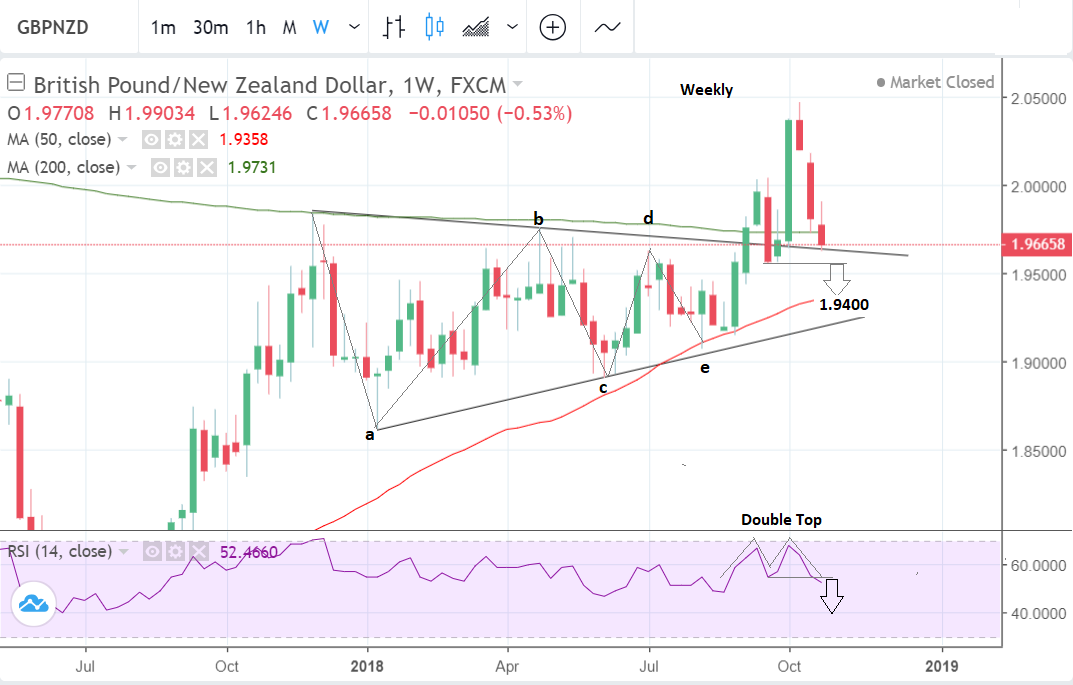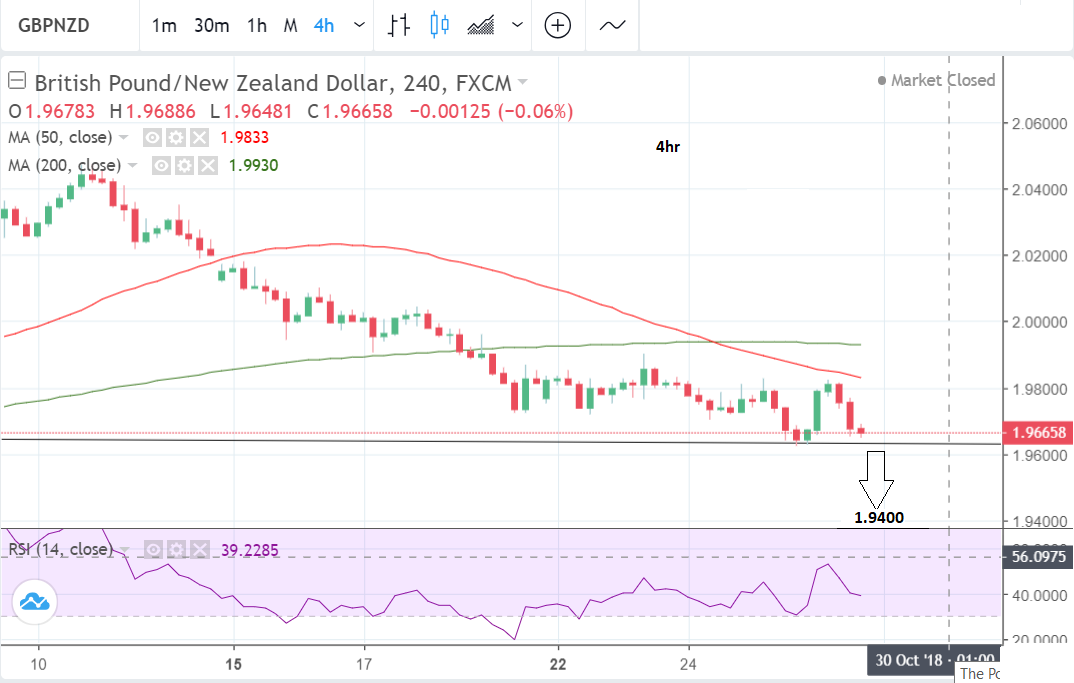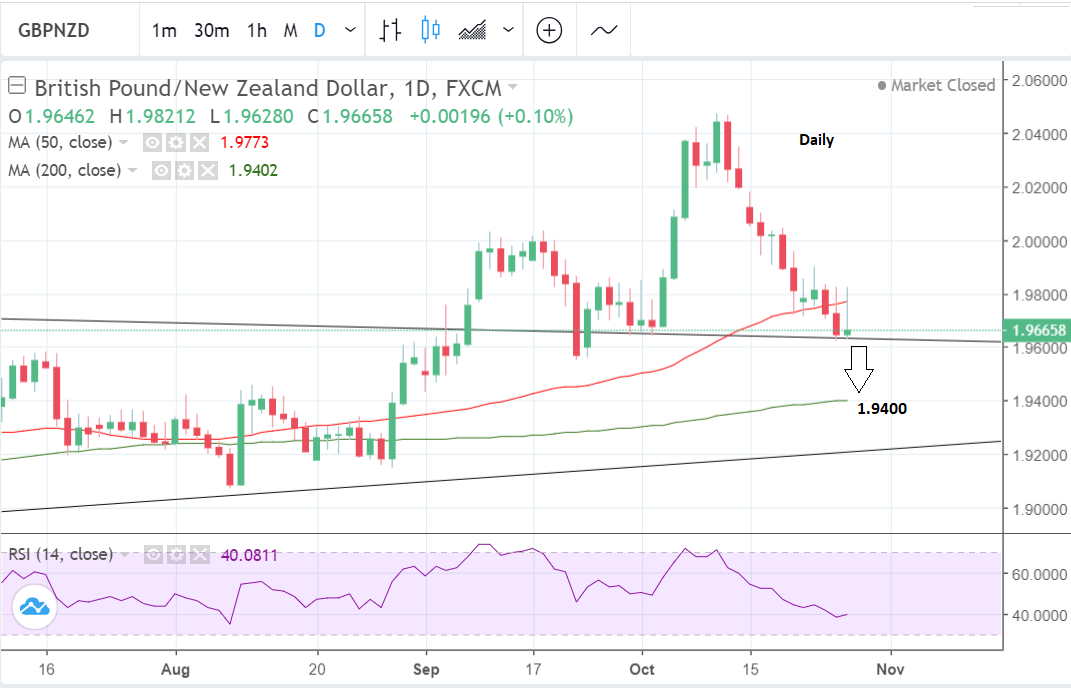Pound-to-New-Zealand-Dollar Rate Downtrend Encounters First Obstacle

© Comugnero Silvana, Adobe Stock
- GBP/NZD hits 'marble floor' at old triangle.
- First test of new downtrend; clear break required.
- GBP eyes BoE, NZD looks to Chinese economic data.
Sterling continued its descent against the New Zealand Dollar last week and has now reached a support level where momentum is likely to ebb from the market.
Support comes from the upper border of the triangle pattern that developed for the greater part of 2018 and the 200-week moving average at 1.9731 is also presenting a barrier south.

Above: Pound-to-New-Zealand-Dollar rate shown at weekly intervals.
Notwithstanding these impediments, the downtrend that has been running for three weeks already should remain in place during the week ahead.
The relative strength index (RSI) momentum indicator has formed a double top reversal pattern at earlier highs that bodes negatively for the exchange rate.
The short-term downtrend is clearer on the 4hr chart below. Assuming the tough floor of support can be broken the downtrend should extend.

Above: Pound-to-New-Zealand-Dollar rate shown at 4-hour intervals.
A break below the upper border of the triangle and the Sep 20 lows at 1.9550 would provide confirmation of another extension lower.
The next target on the horizon is at the 1.9400 lows, or thereabouts, where the 200-day moving average is located. This is likely a robust support level.

Above: Pound-to-New-Zealand-Dollar rate shown at daily intervals.
Advertisement
Bank-beating exchange rates! Get up to 5% more foreign exchange by using a specialist provider to get closer to the real market rate and avoid the gaping spreads charged by your bank when providing currency. Learn more here
The Pound: What to Watch
The main in the week ahead for the Pound is the Bank of England (BOE) interest rate announcement and quarterly inflation report, due on Thursday, 01 November at 13:00.
The BoE is not expected to change its interest rate so markets will focus on the contents of the inflation report and commentary from governor Mark Carney in order to gauge when the bank's next likely move on interest rates will come.
If the BoE's forecasts still show inflation remaining above its target in 2021 then Sterling may find support because markets would infer that the bank remains on course to keep raising interest rates over coming quarters.
Inflation rose to 2.7% in August, from 2.4%, when markets had looked for it to rise to only 2.5%. The recent rise in wages could also factor in the the BoE's forecasts, as that also supports expectations of higher inflation ahead.
Brexit remains the great unknown that might prevent the BoE from revealing its hand too much but assuming the government can agree to a transition period after March, the BOE is likely to raise interest rates again in May 2019 according to ING Group.
"If a majority of MPs approve the agreement in the Parliamentary vote (despite all the current bluster), then the UK will leave the EU on time in March and the transition phase will commence. This somewhat smoother outcome would keep the door open to a May rate hike," says James Knightley, an economist at ING.
Analysts at broker XM.com say the BOE will probably use Thursday's meeting to reiterate its forward guidance for 1-2 rate hikes per year over the next few years.
"It’s less probable that the BoE will modify its guidance of 1-2 rate increases per year over the next few years. The pound could firm slightly if Governor Mark Carney stresses in his press conference that the risks to inflation remain to the upside," says XM.com.
The Autumn budget statement on Monday at 13.30 is another event that could impact the Pound during the week ahead. Economic growth forecasts and government spending plans will have an impact on both bond and currency markets.
UK Manufacturing and Construction PMI's are also due out in the week ahead, with both likely to impact expectations for fourth-quarter economic growth. The manufacturing PMI is expected to fall to 53.0 for October, from 53.8 previously. The construction PMI is seen declining from 52.1 to 52.0.
Advertisement
Bank-beating exchange rates! Get up to 5% more foreign exchange by using a specialist provider to get closer to the real market rate and avoid the gaping spreads charged by your bank when providing currency. Learn more here
The New Zealand Dollar: What to Watch
The key releases in the week ahead for the New Zealand Dollar are building permits, business confidence and consumer confidence data.
While all are useful for gauging economic sentiment, none are of particular importance for market expectations of growth or interest rates so they are unlikely to impact the Kiwi significantly this week.
This will leave the currency at the mercy of events on the global stage, particularly those taking place over in China, which is New Zealand's largest trading partner.
China's NBS Manufacturing PMI survey for October is out Wednesday at 02.00 London time and is expected to show activity in the sector moderating again. The Caixin Manufacturing PMI out Thursday is expected to echo the NBS survey.
Both indices are close to the 50 no-change level, which is a significant watershed level that marks the difference between industry expansion and industry contraction. A move below 50 could be negative for both the Chinese economy and New Zealand Dollar.
Advertisement
Bank-beating exchange rates! Get up to 5% more foreign exchange by using a specialist provider to get closer to the real market rate and avoid the gaping spreads charged by your bank when providing currency. Learn more here









